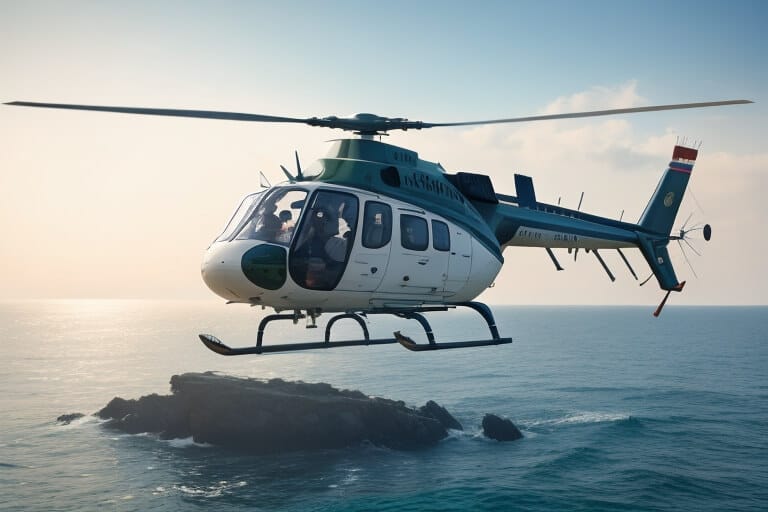
- October 3, 2023
- allix
- Research
Mastering the technique of landing a helicopter on the deck of a ship is a formidable task, especially for Navy pilots. Unlike a conventional runway, a ship’s landing area is compact and constantly in motion due to the sway of the sea. Various attempts have been made to automate ship landings, but none have effectively addressed the unique challenges faced by helicopter pilots, such as gusty winds, low visibility, and other demanding conditions that nature can throw at them.
To tackle this problem, the U.S. Navy is embarking on a mission to develop cutting-edge fully autonomous Vertical Takeoff and Landing (VTOL) aircraft, specifically designed to adapt seamlessly to these adverse conditions. Collaborating with researchers from Texas A&M University, this initiative combines an optimized aircraft design with a robust machine learning algorithm, introducing a novel approach to automating aircraft landings on ships in rough seas.
Dr. Moble Benedict, an associate professor in the Department of Aerospace Engineering at Texas A&M and the project’s principal investigator (PI), explained, “When a helicopter pilot attempts to land on a ship’s deck, their gaze is not fixed on the moving deck itself. Looking directly at the deck can disorient the pilot. Instead, they rely on specialized equipment called the horizon bar, a green, lighted, gyro-stabilized strip that provides them with an artificial horizon.”
While recent studies have focused on tracking the ship’s deck using cameras, GPS, and lidar to match the aircraft’s motion, Benedict and Dr. Dileep Kalathil, an assistant professor in the Department of Electrical and Computer Engineering and co-PI on the project, are taking a different approach. They are automating the landing process by replicating a pilot’s behavior while tracking the horizon bar.
Kalathil elaborated, “Reinforcement learning, an algorithm of machine learning for developing control algorithms for autonomous systems, is at the core of our efforts. We are crafting a reinforcement learning control algorithm so precise that it can track the horizon bar even when the vehicle encounters course changes or heavy winds.”
Benedict and Kalathil have demonstrated success in using reinforcement learning to safely land unmanned aerial systems (UAS) in diverse conditions, including moderate horizontal winds, low visibility, and alterations in course and speed. They are now merging their expertise in aerospace engineering and electrical and computer engineering to build upon these achievements.
Benedict said, “My focus is on designing next-generation VTOL aircraft that excel in gusty conditions and ensure efficiency, potentially incorporating foldable wings for the transition from vertical flight to fixed-wing cruise. Through simulations, wind tunnel tests, and flight trials, we will assess the performance and dynamics of these concepts and develop a scaled-down model to complement Kalathil’s control systems.”
Kalathil, leveraging his proficiency in reinforcement learning, is developing an algorithm capable of robustly handling adverse conditions and rapidly adapting using real-time data, emulating a pilot’s responses.
Kalathil pointed out, “One of the primary challenges in autonomous ship landings is the unpredictable nature of rough seas. By integrating wind sensors into the UAS assembly to measure wind speed and direction, we can counteract these specific conditions effectively.”
This adaptability addresses a critical gap between simulations and real-world scenarios encountered by other development projects. Kalathil is exploring the use of a collaborative console for controlling multiple UAS simultaneously.
Categories
- AI Education (39)
- AI in Business (65)
- AI Projects (87)
- Research (107)
- Uncategorized (5)
Other posts
- Medical Treatment in Brazil: Advanced Healthcare, Skilled Specialists, and Patient-Focused Care
- Dental Treatment in China: Modern Technology, Skilled Dentists, and Comprehensive Care for International Patients
- Plastic Surgery in China: Advanced Aesthetic Medicine Supported by Precision, Innovation, and Skilled Specialists
- Ophthalmology in China: Advanced Eye Care Guided by Innovation, Expertise, and Patient-Focused Treatment
- Finding Care, Calm, and Confidence: Why Patients Are Looking Toward Beroun in the Czech Republic
- Choosing Health, Energy, and a New Future: Exploring Gastric Bypass in Diyarbakır, Turkey
- When Facial Hair Tells Your Story: Considering a Beard Transplant in Phuket, Thailand
- When Prevention Becomes Power: Understanding Liver Cirrhosis Risk and Modern Screening Approaches in Spain
- When the Abdomen Signals Something Serious: Understanding Abdominal Aortic Aneurysm and Getting Expert Evaluation in Islamabad
- When Back Pain Becomes More Than “Just Pain”: Understanding the Need for Microdiscectomy
Newsletter
Get regular updates on data science, artificial intelligence, machine



